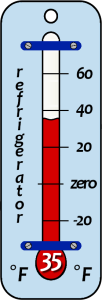With hurricane season upon us, it’s important to know how to prepare our perishable food supply if the power goes out. Knowing how to keep our food supply safe to eat is just as important as gathering your hurricane supplies and creating a plan. By preparing and planning ahead of a storm, you will not only know how to keep yourself and family away from a foodborne illness, but it will also save you money.
Here are some tips for keeping your perishables safe.
Be Prepared and Plan Ahead

 Use a refrigerator and freezer thermometer, and check it regularly to ensure that the refrigerator temperature is at or below 40 degrees F and the freezer is at or below 0 F.
Use a refrigerator and freezer thermometer, and check it regularly to ensure that the refrigerator temperature is at or below 40 degrees F and the freezer is at or below 0 F.- Set refrigerator temperature to less than 35 F, adjusting by a degree or two each day. Set freezer to 0 F or less.
- Freeze refrigerated leftovers, milk, fresh meat, hard cheeses and other such items.
- Freeze water in plastic containers and cans 3-4 days before the storm to fill freezer spaces.
- Stock-up on homemade ice and freeze gel packs to use in your refrigerator, freezer, or coolers.
- Buy appliance thermometers for the refrigerator and freezer.
- Group foods together in the refrigerator and freezer to help foods stay cold longer.
- Have large, insulated cooler and frozen gel packs ready. Find out where dry ice and block ice can be purchased.
- Plan for ice. Know where you can get dry or block ice. Also make ice cubes and freeze containers of water or gel packs to help keep food cold when there is a loss of power.
- Keep a cooler(s) on hand to store refrigerated food if the power will be out for more than four hours.
- Freeze refrigerated items that you may not need immediately, and group foods close together in the freezer.
- Stock your pantry with a few days’ worth of ready-to-eat foods (those that can be consumed without cooking) that do not require refrigeration, frozen storage, or special preparation.
During the Weather Event
Cold temperatures slow the growth of harmful bacteria. Keeping food at safe temperatures is key to reduce the risk of foodborne illnesses.
If the power is off for more than three hours:
- Transfer food to a cooler and fill with ice and/or frozen gel packs.
- Make sure there is enough ice to keep food in the cooler at 40 F or below.
- As the ice melts in the cooler, add more to hold the temperature.
- Use ice (dry or block ice, or ice cubes) and frozen containers of water or gel packs to keep your refrigerator and freezer as cold as possible.
- Keep refrigerator and freezer doors closed as much as possible. The refrigerator will keep food cold for about four hours, and a full freezer will keep the temperature for approximately 48 hours (24 hours if half full) if the doors remain closed.
- Expect to use approximately 2.5-3 pounds of dry ice per cubic foot of freezer.
- Food in the front or door of the freezer will defrost faster than food in the back or bottom of the freezer.
After the Weather Event
![a look inside a refrigerator with an array of fresh and processed foods lining the shelves. [creidt: unsplash.com, darrien staton]](https://blogs.ifas.ufl.edu/sarasotaco/files/2024/06/2024_FCS_foodRefrigerator01_unsplashDarrienStatonEDITSTINY-214x300.jpg) Check the temperatures inside your refrigerator and freezer before eating any food after a power outage. Never taste food to determine its safety.
Check the temperatures inside your refrigerator and freezer before eating any food after a power outage. Never taste food to determine its safety.
- Discard temperature-sensitive food if your refrigerator was without power for more than four hours.
- Perishable foods such as meat, poultry, seafood, milk, eggs, or leftovers with temperatures that are 45 F or below, measured with a food thermometer, should be safe but cook and consume them as soon as possible.
- If the freezer thermometer reads 40 F or below, food is safe and may be refrozen. If you did not have a thermometer in the freezer, check each package to determine its safety; you can’t rely on appearance or odor. If the food still contains ice crystals or is 40 F or below, it is safe to refreeze or cook.
- Be aware that perishable foods that are not kept adequately refrigerated or frozen may cause food poisoning if eaten, even after they are thoroughly cooked.
Register on Eventbrite for How to Handle Your Food for a Weather Event. This 30-minute class will provide some helpful tips on how to store your food to prevent a foodborne illness while also saving you money.
 1
1


